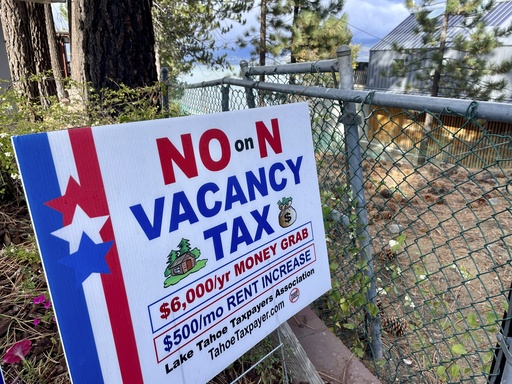
SOUTH LAKE TAHOE, Calif. — Homeowners of vacation properties in South Lake Tahoe, a well-known mountain resort town in Northern California, could face considerable tax hikes if voters endorse a new measure on Tuesday’s ballot. This proposed measure ignites a conflict between the urgent need for affordable housing and the rights of private property owners.
South Lake Tahoe is home to approximately 7,000 vacant residences, representing about 44% of the city’s total housing units, as indicated by the 2022 American Community Survey. Measure N aims to impose a flat fee of $3,000 on homes that remain vacant for at least 182 days each calendar year. If a property stays unoccupied for that timeframe in consecutive years, the tax would escalate to $6,000 annually.
The current scenario reflects a broader national dialogue regarding the implications of vacation rentals. Critics suggest that these vacant second homes contribute significantly to the nation’s housing shortfall, particularly in high-priced resort areas like South Lake Tahoe.
Proponents of Measure N argue that it encourages property owners to either rent their homes to local workers or contribute to a fund aimed at improving housing, transportation, and infrastructure. They claim that the area is losing families as local businesses grapple with finding staff due to insufficient housing options.
Kelly Bessem, who juggles over 50 hours of work each week in roles as a hydrology and land management field scientist and a snowboard instructor, currently sleeps in her car in her quest to buy a house in nearby Markleeville, located about 40 minutes from South Lake Tahoe. “I’ve done everything correctly, yet I’m still struggling,” she expressed.
On the other side of the debate, Nancy Dunn, a part-time resident since 2018, feels that the measure is unjust and undermines property rights. “This is my home, and I deserve the freedom to come back whenever I wish,” she stated while preparing her home with firewood earlier this month. “The American ethos emphasizes property ownership and the desires that come with it.”
In an effort to defeat Measure N, the California Association of Realtors and the National Association of Realtors have mobilized efforts and contributed a total of $1 million in a city with around 12,000 registered voters.
Though still uncommon in the United States, other locations are beginning to implement vacant home taxes to tackle workforce housing shortages by leveraging underutilized homes to expand the long-term rental market. For instance, in Hawaii, the Honolulu City Council’s latest push for an empty homes tax represents its third attempt since 2018. Meanwhile, the Colorado Association of Ski Towns is pursuing legislative measures that would allow localities to propose such taxes to voters.
Margaret Bowes, the executive director of the Colorado group, remarked on the limited options for construction in resort towns, asserting that the dire housing shortage “has reached a crisis level,” severely impacting essential services and local businesses alike.
A prominent example can be seen in Vancouver, Canada, which instituted a tax on empty homes starting at 1% of their assessed value in 2017; it has since escalated to 3% and has reportedly generated $142 million for affordable housing initiatives.
California cities such as San Francisco and Berkeley also approved taxes targeting vacant properties in 2022. While vacancy taxes may be effective in larger metropolitan areas, such policies could wield a considerable impact in smaller towns like South Lake Tahoe, according to Shane Phillips, who oversees the Randall Lewis Housing Initiative at UCLA. Although he refrained from providing an opinion on the proposed tax, he generally supports such measures where housing demand is acute. Taxation can serve to dissuade detrimental practices, likening it to tobacco taxes, he pointed out. “In communities struggling with housing like South Lake Tahoe, the impact of multiple non-occupied homes can adversely affect residents.”
Measure N has ignited considerable tension in the community, which has around 21,000 year-round residents. It is the largest city surrounding Lake Tahoe and remains a favored destination for weekend visitors, located approximately 188 miles northeast of San Francisco. The median household income in the city stands at $68,000, notably lower than California’s $95,000 median. As of September, the median home sale price reached $750,000, a significant increase from $427,000 five years ago.
Inspired by Berkeley’s empty homes tax, city officials estimate that the new tax could generate up to $8 million in its first year and increase to $20 million in subsequent years.
Amelia Richmond, co-founder of Locals for Affordable Housing— the group that successfully collected signatures to place this measure on the ballot— remarked that this represents an essential opportunity for South Lake Tahoe to prevent a downfall similar to other mountain towns grappling with even higher rates of property vacancy.
Property owners would be required to self-report their homes’ occupancy status each year, although they might need to provide documentation. Certain situations, such as homes under renovation, would be exempt. To evade the tax, vacation homeowners might consider selling their properties, renting them out year-round, or leasing them to seasonal tourists or workers. The city has previously restricted short-term rentals of under 30 days, citing noise and housing shortages as reasons for action.
Opponents argue that many have worked tirelessly to invest in modest second homes, and they should not be penalized for the broader lack of affordable housing in the region. They also express frustration over their inability to vote on the measure, as part-time residents.
Tom Fields, 85, divides his time between a modest three-bedroom residence he values for its location by Lake Tahoe and another home in central Oregon. “This seems absurd and may even be unconstitutional,” he commented. “When property rights begin to erode after purchasing land, it understandably incites frustration among owners.”
